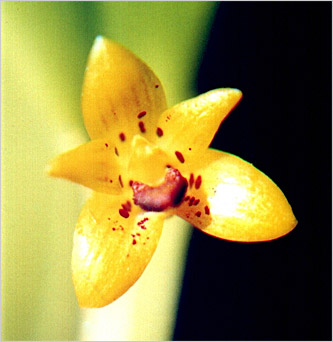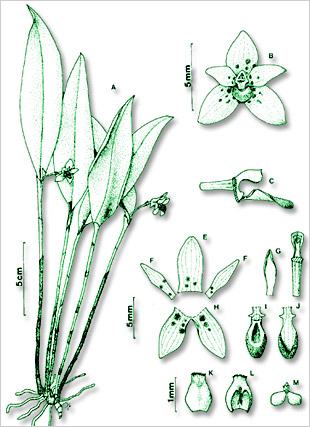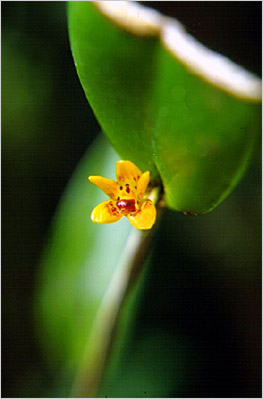 |
Claudio
Nicoletti de Fraga Instituto de Pesquisas Jardim Botanico do Rio de Janeiro Programa Zona Costeira/Curadoria de Colecoes Vivas Rua Jardim Botanico, 1008, 22470–051 Jardim Botanico, Rio de Janeiro-RJ, Brazil cnfraga@jbrj.gov.br |
Ludovic
Jean Charles Kollmann Museu de Biologia Prof. Mello Leitao Av. Jose Ruschi, 4, 29650–000 Santa Teresa, Espirito Santo-ES, Brazil ludovic@escelsa.com.br |
 |
| ABSTRACT.
Myoxanthus ruschii (Orchidaceae), a new species from the Santa Lucia Biological Station in the Atlantic forest of Espirito Santo, Brazil, is described and illustrated. This new species is related to Myoxanthus punctatus, Myoxanthus lonchophyllus, and Myoxanthus seidelii, from which it differs by non-clavate petals and the general form of the lip with a subtruncate base with a pair of reflexed lateral lobes on the end. Key words: Atlantic forest, Brazil, Espirito Santo, Myoxanthus, Orchidaceae. |
| The
eastern Brazilian Atlantic coastal forest, although at present highly
fragmented, is one of the places with the highest biodiversity on Earth
(Myers et al., 2000). One of these fragments with special interest is
the Santa Lucia Biological Station, a site for biological research and
conservation encompassing about 440 ha of Atlantic forest located in the
municipality of Santa Teresa, in the state of Espirito Santo. According
to recent research on trees, birds, mammals, and butterflies there is
an especially high biological richness in this region, even when compared
with other Atlantic forest areas (Mendes & Padovan, 2000). As a result
of fieldwork at this station, we have found a new orchid species that
is described and illustrated in this paper. The Neotropical genus Myoxanthus Poeppig & Endlicher, long in the synonymy of Pleurothallis, was reinstated by Luer (1982). Later, Luer (1992, 1997) presented a revision of the genus, consisting of 48 species in 3 subgenera, subg. Satyria Luer, subg. Silenia Luer, and subg. Myoxanthus, with this last subgenus containing section Myoxanthus, section Antennella Luer, and section Scandentia Luer. Seven species were cited for Brazil for the autonymic subgenus of Myoxanthus: four endemic to the eastern Atlantic forest, two in the Amazonian region, and one with disjunct distributions in eastern Brazil and northwestern South America. |
 |
Figure
1. Myoxanthus ruschii Fraga & L. Kollmann, NOVON 13: 49-51. 2003. A. Habit and inflorescence B. Flower C. Ovary, column, and lip, side view in normal position D. Ovary and column, from below E. Dorsal sepal F. Petal, from above G. Petal, from below H. Lateral sepal, from above I. Lip, from above J. Lip, from below K. Anther, from above L. Anther, from below M. Pollinia Drawn from the type specimen (C. N. Fraga 780), by C. N. Fraga. |
| Species haec Myoxantho punctato, M. lonchophyllo et M. seideli affinis, sed floribus parvis successivis pedunculatis aggregatis, sepalo postico oblongo, sepalis lateralibus oblongis apice obtusis, petalis elliptico-ovatis, labellis trilobatis, et lobo antico elliptico-ovato, marginibus verrucosis, et lateralibus brevibus retrorsis differt. |
| Epiphytic,
caespitose herb. Roots coarse. Ramicauls 14–21 3 0.15–0.2
cm, ascending to erect, stout, and enclosed by 5 to 8 purple-colored, tubular hispidulous and paleaceous sheaths. Leaf 8.5–13 3 2–3 cm, erect, thickly coriaceous, narrowly elliptic to narrowly ovate, acute, base cuneate below into a subpetiole. Inflorescence a fascicle of single, successive flowers, at the apex of the ramicaul, occasionally 2 flowers at anthesis simultaneously, the peduncles purple, 7–9.5 mm long, minutely purple pubescent; floral bracts 3–5 3 2–2.5 mm wide |
| expanded,
paleaceous, purple pubescent. Flowers resupinate; pedicels 2–3 mm long; ovary 2–4 mm long; sepals yellow with red spots, glabrous, the dorsal sepal 7–8 3 2.5–3 mm, oblong, narrowly subacute, 5-veined, the lateral sepals 7– 8 3 3–3.5 mm, connate at the base, oblong-ovate, apex rounded, 4(–6)-veined; petals 7–8 3 2–2.5 mm, yellow with red spots, glabrous, narrowly elliptic- ovate, obtuse, with revolute margins at the apex, 3-veined; labellum 5–6 3 2–2.5 mm, red with yellow base, non-deflexed, glabrous, the apical lobe elliptic, obtuse, somewhat verrucose with revolute margins, thick, the lower half with low, erect, rounded margins, the disc with a broad, smooth, slightly concave area, the base subtruncate, with a pair of minute lateral lobes reflexed on the end, 3- veined; column 1–1.5 3 0.5 mm, yellow, flecked with red, stout incurved, 3 mm long, with rounded wings above the middle, the column-foot stout, 2 mm long, concave, with a pair of thick calli near the apex, the upper margin of the anther fimbriate, 2 pollinia-pairs, yellow, obovoid. Capsule unknown. |
 |
|
The name of the new species pays homage to Augusto Ruschi, a naturalist
involved in the conservation of natural areas in Espirito Santo, especially through the Santa Lucia Biological Station, which was where he started his botanical studies, particularly with Orchidaceae. The new species is apparently related to Myoxanthus punctatus (Barbosa Rodrigues) Luer, M. lonchophyllus (Barbosa Rodrigues) Luer, and M. seidelii (Pabst) Luer, from which it is distinguished by its elliptic leaves, labellum thick and non-deflexed with revolute margins, and fimbriate anther. The presence of an elliptical labellum with the terminal lobule having a verrucose margin, also observed in Myoxanthus punctatus and M. seidelii, distinguishes M. ruschii from M. lonchophyllus, which has an ovate labellum, somewhat hispid-papillose apically. The yellow coloring with red spots, non-clavate petals, and general elliptic form of the labellum with subtruncate base with a pair of lateral lobes reflexed on the end, found in Myoxanthus ruschii, are characters absent in M. punctatus and M. seidelii. |
| TYPE:
Brazil. Espirito Santo: Santa Teresa, Valsugana Velha, Santa Lucia Biological Station, dry trail, ca. 198579100–198599000S, 40831930–408329250W, elev. 750 m, 16 June 2001 (fl), C. N. Fraga 780 (holotype, MBML; isotype, RB). PARATYPE: BRAZIL. Espirito Santo: Santa Teresa, Valsugana Velha, Santa Lucia Biological Station, dry trail, ca. 198579100–198599000S, 408319300–408329250W, 700 m, Atlantic forest, 28 Apr. 2000 (fl), L. J. C. Kollmann 2899, C. N. Fraga, V. G. Demuner, E. M. C. Leme & B. R. Silva (MBML). Acknowledgments. We acknowledge Conselho Nacional de Desenvolvimento Cientifico e Tecnologico (CNPq) for financial support, Helio de Queiroz Boudet Fernandes, Director of the Mello Leitao Biological Museum and MBML herbarium curator, for assistance during fieldwork in Santa Teresa, Jorge Fontella Pereira for the Latin diagnosis, and Fabio de Barros, Marcos Sobral, and two reviewers and the editor for suggestions and help with the English. Literature Cited - Luer, C. A. 1982. A reevaluation of the genus Myoxanthus (Orchidaceae). Selbyana 7: 34–54. - 1992. Icones Pleurothallidinarum IX: Systematics of Myoxanthus. Addenda to Platystele, Pleurothallis subgenus Scopula and Scaphosepalum. Monogr. Syst. Bot. Missouri Bot. Gard. 44: 1–128. - 1997. Icones Pleurothallidinarum XV: Systematics of Trichosalpinx. Addenda to Dracula, Masdevallia, Myoxanthus and Scaphosepalum. Corrigenda to Lepanthes of Ecuador. Monogr. Syst. Bot. Missouri Bot. Gard. 64: 1–136. - Mendes, S. L. & M. P. Padovan. 2000. A Estacao Biologica de Santa Lucia, Santa Teresa, Espirito Santo. Bol. Mus. Biol. Mello Leitao (n. ser.) 11/12: 7–34. - Myers, N. R. A., C. G. Mittermeier, G. A. B. Fonseca & J. Kent. 2000. Biodiversity hot spots for conservation priorities. Nature 403: 853–858. |
| Photos
and illustration: Cláudio Nicoletti de Fraga Digital manipulation: Sergio Araujo |